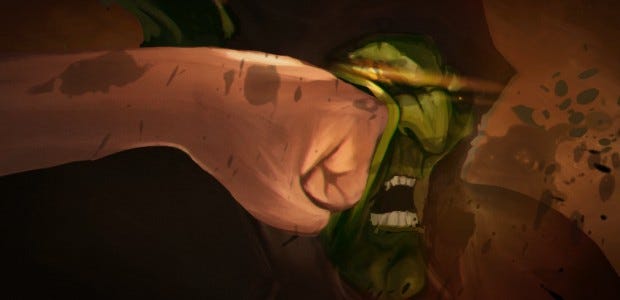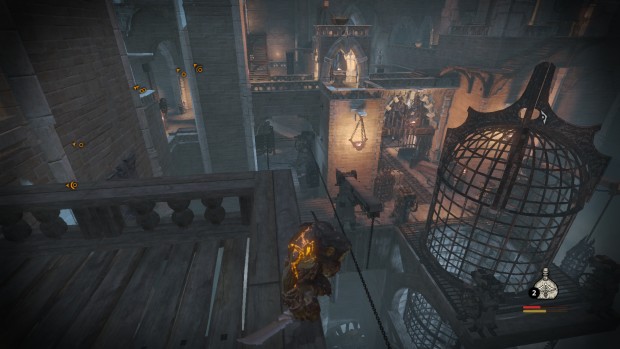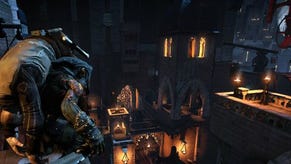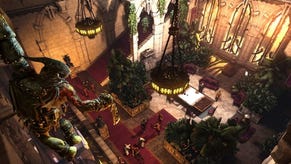Wot I Think - Styx: Master Of Shadows
Hit Me With Your Rhythm, Styx
Development company Cyanide have long been purveyors of interesting-but-guff fantasy games. Styx: Master of Shadows turns out to be their least-interesting-but-most-good. It's a stealth game in which you play a goblin - the Styx of the title - sneaking around the Tower of Akenash, a medieval city built so high among the branches of "the World-Tree" that ledges stretch down into a cloudy abyss.
It's also a strict stealth game: one in which triggering combat means almost certain death, and where you'll spend your time mastering the shadows by hiding in them rather than pouncing from them.
This is rare, now. The drive towards making players feel more powerful means that every Sam Fisher eventually leaps over the table he used to hide behind, and simply starts beating up the people he was once afraid of. Styx charts a more difficult path, relying on the feeling of empowerment you get from exploring its vast, open environments.
It works, a lot of the time. Being in a city built on top of a tree in the sky means that you spend a lot of your time moving vertically, leaping between ledges, navigating via convenient hand-holds, and plotting paths of least resistance to whatever your target is. You'll move into a room by ducking behind boxes, holding down the right-trigger to cling to a wall and tossing handfuls of sand to extinguish torches, but if the need to crouch and skirt ever begins to feel smothering, you're almost always able to find a path up a wall to some ceiling beams, or to a second or third floor.
Each mission is split into four parts, and to give you a sense of scale, each of those parts contains upwards of around 40 guards. You'll visit an embassy, a prison, some sewers, and almost everything will be grey and bleak, but there are regularly entire wings to buildings that are off the critical path, making it feel like you're mastering the space in your slow exploration and discovery of it. There's also just enough weirdness or grandeur - in an embassy and airship port, or in the tree branches that twist and coil through certain levels - to make up for a lot of low-resolution or misaligned textures.
To aid your sneaky exploration, you'll rely on Styx's limited abilities. The clear gimmick is your ability to create clones: using Amber as a magic source, you can place down a crawly-goblin doppelgänger and take control of it just as you do Styx. This begins as a way of solving simple door-opening puzzles; your clone can crawl through grates you cannot, and hit switches on the otherside. As you finish missions and earn XP though, you can unlock new abilities. One allows your clone to grab enemies from behind, so you can switch back to Styx and sneak by undetected. Another lets you hide your clones in wardrobes and chests, and tell them to drag inside and kill the first guard that walks by.
Styx himself can be similarly upgraded, to carry more equipment, make less noise, be able to perform aerial assaults, and other abilities across six categories. The upgrades stop short of every truly making you feel powerful, and perhaps consequently, of ever truly being interesting.
Mostly the game remains flat and repetitive across the course of the story - your need to remain in the shadows means that you'll want to extinguish torches with your hands or with sand if from afar, and you'll want to take the time to slowly 'Muffle kill' guards and hide their bodies so their friends don't find them. This was how I got through almost every single challenge in the game, in spite of unlocking actions like being able to turn briefly invisible.
If you ever screw up and get caught, there's a little wiggle room in the guard's various alert statuses. At first glimpse, a bar will appear above their head indicating that they think they've seen something. Hide quickly and they'll dismiss it as rats. If that bar fills, they'll walk to the location to investigate and look around nearby corners. Again, hide quickly enough and they dismiss it as rats, but they're smart enough to yank you out of wardrobes or chests they suspect you might be hiding inside. If this alert bar fills, they draw their sword and run towards you.
If any enemy gets close enough to you while on alert, you'll be 'locked in' to combat with them. This means that you're unable to turn away from the fight and flee. Which wouldn't be so bad, except you can't traditionally attack at this point. Instead you have to block between one and three of your opponent's swings until they're staggered, at which point you'll have a brief window in which you can perform a single-strike kill move on them. Timing those parries is difficult enough, but even if you manage to perform the button presses at just the right moments, it's likely the ruckus will have attracted more nearby guards to the scene. They don't wait in line to attack you like compliant Assassin's Creed AI, and given that more than half the enemies seem to carry ranged throwing knives alongside maces and swords, it's likely you'll be quickly clubbed to death.
This makes the game tense and the stealth meaningful, but combines with the game's major flaw, in that it's also also often repetitive and frustrating. That flaw is the controls.
This used to be a common problem in platform games. You want to drop down and grab on the ledge of the surface you're currently standing on. A simple request, but one that's fucking infuriating when the game can't decide whether you want to drop down and fall or drop down and come immediately back up. It happened to me a hundred times, and each time coming immediately back up would mean I was spotted by a guard and falling down meant I disappeared into the smoky void and died. Even when you're trying to do something simpler, like jump between two adjacent platforms, the game's edge detection is flakey, making it unpredictable as to whether Styx would grab on to the wooden beam you were aiming for, some small outcrop of wall nearby, or nothing at all.
Either way, the unforgiving stealth mean that these mistakes most often force you back to the last save. Those saves are either checkpoints - too few and far between to rely on - or manual saves you can make via the menu at any time. The result is that I saved after passing every single room in the game for fear of having to repeat something hard or boring the next time the controls sent me to my doom.
Near the end, the repetition becomes too much. There's variety in the enemies, such as guards that can't be backstabbed, magical bugs who are blind but have super-hearing, and more. Levels are also large and fun to explore, and it's unlikely you'll discover everything or master the possible no-kill, no-sight playthrough on your first visit. But the story pushes its luck when the third mission requires you to backtrack through the building you've just sneaked inside. When I reached mission five, over ten hours in, and discovered that it was about doing mission four in reverse, my heart sank. There are six missions in all.
Styx's adherence to strict definitions of a stealth game mean that it feels compellingly old-fashioned. It's nice to play a stealth game again where seeing carpet underfoot is a blessed relief. It's also nice that it's not a wholly retro game, in that it's clearly learned lessons from Batman and Dishonored as far as how to communicate information visually.
But Styx sets appropriate player expectations early: it costs £25/$25, half the price of many of its competitors. A lot of the time, cost is a shaky thing on which to measure a game - potential buyers know themselves how far their coffers will stretch - but being aware of the tight budget the game was presumably made on gets you halfway towards understanding much of Styx's design. It doesn't excuse the flaws, especially those control problems, but it explains why its textures look how they do, why no QA process wiped away those fiddly frustrations, and why it's as focused on offering a single type of experience as it is. Given that the focus is also it's biggest strength, it feels like a good example of making the most of what you've got.
You're not going to love Styx. It's not the kind of game you're going to be itching for a sequel to. It seems kind of unfortunate that it was released within a week of Middle-earth: Shadow of Mordor and Alien: Isolation. But sometime five or ten years from now you'll be talking about stealth games with a friend and you'll go, "Oh, hey, remember Styx? That was pretty good."
Your friend probably won't have played it, but that just means you get to feel smarter than them.
Styx: Master of Shadows is out now and on Steam.















